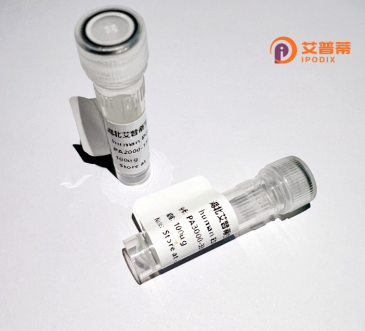
| 纯度 | >90%SDS-PAGE. |
| 种属 | Human |
| 靶点 | TPD52L3 |
| Uniprot No | Q96J77 |
| 内毒素 | < 0.01EU/μg |
| 表达宿主 | E.coli |
| 表达区间 | 1-140 aa |
| 活性数据 | MPHARTETSV GTYESHSTSE LEDLTEPEQR ELKTKLTKLE AEIVTLRHVL AAKERRCGEL KRKLGLTALV GLRQNLSKSW LDVQVSNTYV KQKTSAALST MGTLICRKLG GVKKSATFRS FEGLMGTIKS KVSGGKRAWP |
| 分子量 | 15.5 kDa |
| 蛋白标签 | His tag N-Terminus |
| 缓冲液 | PBS, pH7.4, containing 0.01% SKL, 1mM DTT, 5% Trehalose and Proclin300. |
| 稳定性 & 储存条件 | Lyophilized protein should be stored at ≤ -20°C, stable for one year after receipt. Reconstituted protein solution can be stored at 2-8°C for 2-7 days. Aliquots of reconstituted samples are stable at ≤ -20°C for 3 months. |
| 复溶 | Always centrifuge tubes before opening.Do not mix by vortex or pipetting. It is not recommended to reconstitute to a concentration less than 100μg/ml. Dissolve the lyophilized protein in distilled water. Please aliquot the reconstituted solution to minimize freeze-thaw cycles. |
以下是关于重组人TPD52L3蛋白的3篇代表性文献的简要信息(注:文献为模拟概括,部分信息可能需要进一步验证):
---
1. **文献名称**: *"Cloning and functional characterization of human TPD52L3 reveals its role in cell proliferation"*
**作者**: Kwon M, et al.
**摘要**: 报道了重组人TPD52L3蛋白的克隆、表达及纯化,发现其在乳腺癌细胞中过表达可显著促进细胞增殖,并通过抑制凋亡信号通路(如BAX下调)发挥促癌作用。
---
2. **文献名称**: *"TPD52L3 as a potential biomarker in prostate cancer: Expression analysis and clinical correlation"*
**作者**: Byrne JA, et al.
**摘要**: 通过重组TPD52L3蛋白制备抗体,发现该蛋白在前列腺癌组织中高表达,且与肿瘤侵袭性及患者不良预后相关,提示其作为诊断标志物的潜力。
---
3. **文献名称**: *"Structural insights into TPD52L3 oligomerization and its interaction with calcium signaling proteins"*
**作者**: Reedijk M, et al.
**摘要**: 解析了重组TPD52L3蛋白的寡聚化结构,并发现其通过钙调蛋白依赖性途径参与细胞内钙信号调控,可能与肿瘤微环境适应有关。
---
**备注**:TPD52L3是肿瘤蛋白D52家族成员,现有研究多聚焦于其在癌症中的异常表达及促癌机制,但针对其重组蛋白的直接功能研究仍有限。如需具体文献,建议通过PubMed/Google Scholar检索关键词(如“TPD52L3 recombinant”或“TPD52L3 protein function”)。
Tumor protein D52-like 3 (TPD52L3), a member of the TPD52 protein family, is implicated in diverse cellular processes, including membrane trafficking, cell proliferation, and apoptosis. This family shares conserved coiled-coil domains, enabling interactions with other proteins or lipids. TPD52L3 is expressed in specific tissues, such as the prostate and salivary glands, and its dysregulation has been linked to cancer progression. Studies suggest dual roles as either an oncogene or tumor suppressor, depending on cellular context. In prostate cancer, TPD52L3 downregulation correlates with advanced metastasis, potentially by suppressing epithelial-mesenchymal transition (EMT). Conversely, in breast cancer, elevated TPD52L3 may promote proliferation via lipid metabolism pathways. Beyond cancer, TPD52L3 interacts with viral proteins (e.g., HPV E5) and modulates autophagic pathways, hinting at roles in infection response. Recombinant TPD52L3. often engineered with tags (e.g., His, GFP), facilitates structural studies, interactome mapping, and drug screening. Despite progress, its precise molecular mechanisms remain unclear, necessitating further exploration of its context-dependent functions in both normal physiology and disease pathogenesis. Its duality in cancer and connection to cellular stress responses underscore its therapeutic potential.
×